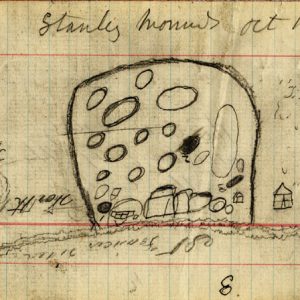calsfoundation@cals.org
Edwin Curtiss (1830–1880)
Edwin Curtiss, a nonprofessional field man who excavated archaeological sites and collected antiquities, is credited by Arkansas archaeologists with making the first scientific archaeological excavation in their state. In 1879 and 1880, Curtiss and his associates spent eighty-six days excavating at ancient Native American village sites along the St. Francis River in northeast Arkansas, where he collected nearly 1,000 pottery vessels and hundreds of other specimens for Harvard University’s Peabody Museum of American Archaeology and Ethnography.
Edwin Curtiss was born on January 27, 1830, in North Lansing, New York. Originally a tailor by trade, Curtiss served in the Union army during the Civil War, subsequently moving with his family to Tennessee. After the war, Curtiss worked as an independent contractor on levee, bridge, and railroad construction projects. He collaborated with Frederic Ward Putnam, director of the Peabody Museum, in the latter’s excavations in Tennessee in 1877 before he went in the field on his own, collecting antiquities for the Peabody in Tennessee in 1878.
Curtiss arrived in Little Rock (Pulaski County) by train on September 25, 1879. Curtis probably learned of the mounds and cemeteries of Arkansas’s St. Francis River country during his work on government jobs in that state. Though Curtiss’s primary destination in Arkansas was the St. Francis River country, he appears to have delayed his departure from Little Rock because of a yellow fever quarantine. While in Little Rock, Curtiss briefly excavated at the nearby Toltec Mounds and prepared a sketch map of that site.
Curtiss left for northeast Arkansas at the end of October and spent the following winter excavating along the St. Francis River. Unable to hire local labor, Curtiss employed hands from his former work in Tennessee. They excavated at the archaeological sites known today as Parkin, Neeley’s Ferry, Togo, Fortune, Vernon Paul, Williamson, and Rose Mound, all in Cross County. Curtiss suspended work in Arkansas in mid-March 1880 because of rising floodwaters.
Many objects collected by Curtiss in northeast Arkansas date from roughly AD 1200 to 1600. Archaeologists today assign these sites, along with contemporaneous sites throughout much of eastern North America, to the Mississippian culture.
The northeast Arkansas pottery that Curtiss collected for the Peabody, along with specimens from the Smithsonian Institute’s mound explorations in the state a few years later, served for decades as the primary source for characterizing the repertoire of early Indian ceramic artists of the lower Mississippi Valley. They include red and white painted vessels and effigy pots that depict complete fish and frogs; heads of opossums, birds, and mythological creatures; and a striking naturalistic painted human head vase.
In addition to collecting objects, Curtiss recorded observations on graves and their contents and prepared maps of the sites and their environs.
Curtiss died on December 6, 1880, in Nashville, Tennessee, of a sudden heart attack.
For additional information:
House, John H. Gifts of the Great River: Arkansas Effigy Pottery from the Edwin Curtiss Collection, 1879–1880. Collections Series, Peabody Museum of Archaeology and Ethnology. Cambridge: Harvard University Press, 2003.
Mainfort, Robert C. Jr., and Sarah R. Demb. “Edwin Curtiss’s Archaeological Explorations along the St. Francis River, Northeast Arkansas, 1879–1880.” Arkansas Archeologist 41 (2001):1–27.
John H. House
Arkansas Archeological Survey
 Stanly Mounds
Stanly Mounds 




Comments
No comments on this entry yet.